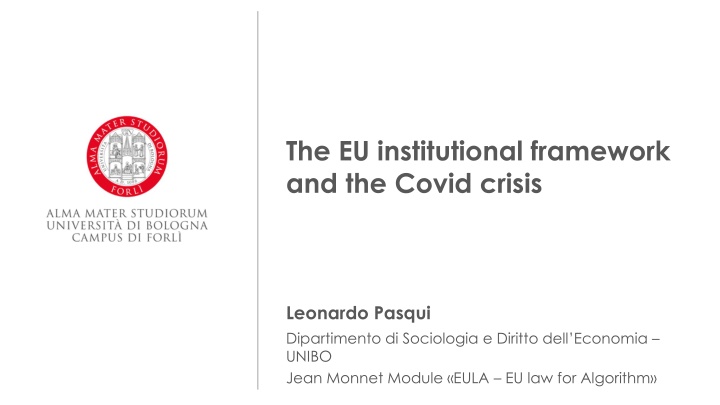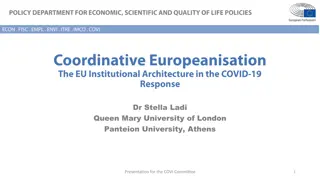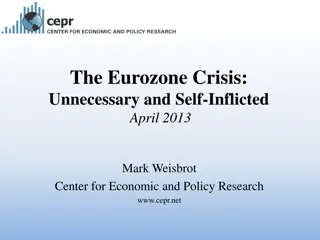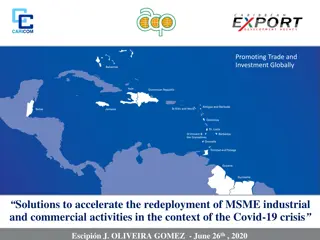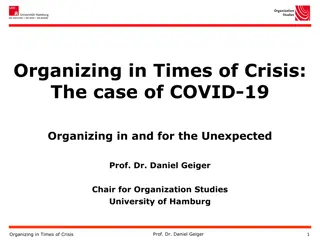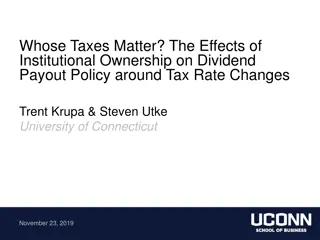The EU Institutional Framework and the Covid Crisis
The Covid-19 crisis hit Europe in February 2020, leading to closures and restrictions in all EU countries. The European Commission suspended the Stability and Growth Pact, approved a Temporary Framework on State Aid, and the ECB established the PEPP to stabilize the economy. The EU also redirected funds, introduced the SURE program, and reshaped the multi-year budget for 2021-2027 amidst the crisis. The creation of a new European instrument was proposed but faced opposition from certain member states.
Download Presentation

Please find below an Image/Link to download the presentation.
The content on the website is provided AS IS for your information and personal use only. It may not be sold, licensed, or shared on other websites without obtaining consent from the author.If you encounter any issues during the download, it is possible that the publisher has removed the file from their server.
You are allowed to download the files provided on this website for personal or commercial use, subject to the condition that they are used lawfully. All files are the property of their respective owners.
The content on the website is provided AS IS for your information and personal use only. It may not be sold, licensed, or shared on other websites without obtaining consent from the author.
E N D
Presentation Transcript
The EU institutional framework and the Covid crisis Leonardo Pasqui Dipartimento di Sociologia e Diritto dell Economia UNIBO Jean Monnet Module EULA EU law for Algorithm
THE COVID-19 CRISIS From February 2020, Covid-19 cases began to hit Europe as well, causing successive and progressive closures and restrictions in all EU countries, starting with Italy. In this context, both the national and supranational dimensions intervened to support the European economy. Nevertheless, it is clear that the former was inextricably linked to the latter with respect to the actual margins of intervention.
THE COVID-19 CRISIS On this point, already in March 2020, the European Commission decided to suspend the Stability and Growth Pact and to approve a Temporary Framework on State Aid. Both measures went in the direction of giving support and freedom to national governments to intervene at socio-economic level to support citizens and enterprises.
THE COVID-19 CRISIS At the same time, the ECB's role has been to establish a financial stabilisation and purchase programme for the euro area, called PEPP (pandemic emergency purchase programme). The value of this initiative is approximately EUR 1850 billion and has had the effect of not raising interest rates excessively while injecting liquidity into the system.
THE COVID-19 CRISIS The EU then helped Member States to redirect the still unspent funds of the 2014-2020 seven-year period towards limiting the most damaging effects of the pandemic. Furthermore, a new programme, called SURE, was introduced, amounting to some 100 billion, with the aim of giving temporary support to workers, through loans to the Member States, in fact acting as a 'European Insurance Fund'.
THE COVID-19 CRISIS Besides these temporary measures, the new 2021-2027 multi-year budget had to be approved. . The discussion on this point had started in May 2018 with the Commission's first proposals. However, the changed scenario of the crisis forced supranational institutions and MS governments to rethink and redefine the seven- year term.
THE COVID-19 CRISIS On this point, the first step was taken by nine countries (Belgium, France, Greece, Ireland, Italy, Luxembourg, Portugal, Slovenia and Spain), which, on 25 March 2020, in a joint document called for the creation of a new European instrument. This request was rejected by the so-called 'frugal' states, which proposed alternative instruments such as the ESM, creating a specific line for healthcare costs.
THE COVID-19 CRISIS On 18 May 2020, however, France and Germany proposed a new European fund worth EUR 500 billion, financed by common European debt. Only two days later, Austria, Denmark, the Netherlands and Sweden reacted by rejecting the Franco-German idea and once again proposed the idea of an ESM-like instrument.
THE COVID-19 CRISIS The European Commission follows up on the idea that emerged from France and Germany by proposing the Next Generation EU plan, consisting of grants and loans. In this regard, some scholars talked about an Hamiltonian moment for the European Union, recalling the US Treasury Secretary who in 1790 decided to create a common federal debt, overcoming the divisions between the different states.
THE COVID-19 CRISIS After two months of negotiations, on 21 July 2020, the European Council reached an agreement on the Next Generation EU and the MFF 2021-2027. The final text envisages EUR 750 billion for the NGEU rebalanced with a higher percentage of loans (from EUR 250 billion to EUR 360 billion) and a lower percentage of grants (from EUR 500 billion to EUR 390 billion).
THE COVID-19 CRISIS The legal basis of the Plan is the: - Art. 122(2) TFEU: establishes the possibility for the EU to provide financial assistance when a MS is in difficulties or seriously threatened with severe difficulties. This article, therefore, emphasises the exceptional and temporary nature of the instrument. - Art. 175(3) TFEU: key norm and pillar for cohesion policy.
THE COVID-19 CRISIS Each Member State subsequently drew up a National Recovery and Resilience Plan in which it listed a series of investments and reforms that would meet the European timeframe and targets. Italy was the country that decided to take the most loan and grant resources from Next Generation EU.
THE COVID-19 CRISIS The Next Generation EU plan is also complemented by the 2021- 2027 budget, which will also generate new resources for Europe's post-Covid recovery. Nevertheless, the outbreak of war in Ukraine as well as the energy crisis the EU is currently experiencing has raised the question of intervening again through a new plan or by changing some of the parameters and objectives of the Next Generation EU.
Leonardo Pasqui leonardo.pasqui2@unibo.it www.unibo.it
